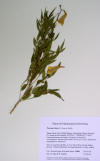|
Tecoma stans |
|
|
Marzouk M., A. Gamal-Eldeen, M. Mohamed and M. El-Sayed. 2006. Anti-proliferative and antioxidant constituents from Tecoma stans. Z. Naturforsch [C]. 61(11-12): 783–791. “Phytochemical investigation of Tecoma stans Juss. fruits and flowers resulted in the isolation of a new phenylethanoid, 2-(3,4-dihydroxyphenyl)ethyl-2-O-[6-deoxy-alpha-L-mannopyranosyl-4-(3,4-dihydroxyphenyl)-2-propenoate]-beta-D-glucopyranoside (3), and a novel monoterpene alkaloid, 5-hydroxy-skytanthine hydrochloride (8), along with eleven known compounds; 4-O-E-caffeoyl-alpha-L-rhamnopyranosyl-(1' --> 3)-alpha/beta-D-glucopyranose (1), E/Z-acetoside (2), isoacetoside (4), rutin (5), luteolin 7-O-beta-D-neohespridoside (6), luteolin 7-O-beta-D-glucopyranoside (7) and sucrose (9) were isolated from the fruits, while luteolin 7-O-beta-D-glucuronopyranoside (10), diosmetin 7-O-beta-D-glucuronopyranoside (11), diosmetin 7-O-beta-D-glucopyranoside (12), diosmetin 7-O-beta-D-glucuronopyranoside methyl ester (13) and acetoside (2) were isolated from the flowers. Their chemical structures have been determined on the basis of chemical and spectroscopic evidences. Biological investigations of a T. stans fruits extract and compounds 1, 2, 4, and 8 indicated that the extract, 1, 2, and 4 possessed a strong scavenging activity to DPPH, peroxyl and hydroxyl radicals. Unlike 4, which potentially induced NO generation in bacterial lipopolysaccharide-stimulated raw murine macrophage (RAW 264.7), the extract, 1, 2, and 8 significantly inhibited the NO generation. The extract, 2 and 4 exhibited a cytotoxic effect on human hepatocarcinoma cells (Hep-G2), while the extract, 2 and 8 were potent growth inhibitors of human breast carcinoma cells (MCF-7). 1 and 2 were remarkable growth inducers of human lymphoblastic leukemia cells (1301), whereas the extract, 2, and 8 stimulated the macrophage proliferation rate. Taken together, the novel compound 8 is effective as anti-proliferative agent against MCF-7 cells and as NO inhibitor, whereas 2 exhibited multi-functional properties as antioxidant and anti-proliferative agent against both solid tumor cell lines Hep-G2 and MCF-7 cells.”
|
|
